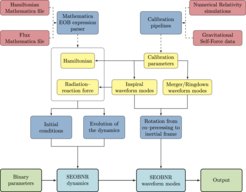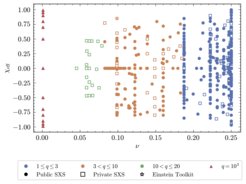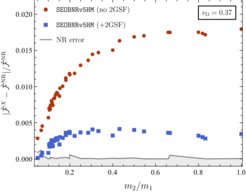Next generation waveform models for observing run O4
Five papers about state-of-the-art, computationally efficient inspiral-merger-ringdown gravitational waveforms developed by AEI-Potsdam researchers
Successful searches, correct identification of the sources, and precise inference of their astrophysical and cosmological properties require detailed knowledge of the expected waveforms. The increasing sensitivity of the detectors must be reflected in more accurate and more physically complete gravitational-wave models which should still be computationally efficient. In preparation for O4, a team of researchers from AEI Potsdam developed ever more accurate waveform models within the effective-one-body (EOB) formalism to search for and extract more information from the detector data. In particular, the newly developed models improve the accuracy of tracking spin precession, include a larger number of higher harmonics – all this while being several times faster than before. In order to cope with the expected large number of detections a new code infrastructure (pySEOBNR) for efficient inclusion of new physical effects and rapid generation of waveform models was also developed.
[1] pySEOBNR: a software package for the next generation of effective-one-body multipolar waveform models
Paper abstract

We present pySEOBNR, a Python package for gravitational-wave (GW) modeling developed within the effective-one-body (EOB) formalism. The package contains an extensive framework to generate state-of-the-art inspiral-merger-ringdown waveform models for compact-object binaries composed of black holes and neutron stars. We document and demonstrate how to use the built-in quasicircular precessing-spin model SEOBNRv5PHM, whose aligned-spin limit (SEOBNRv5HM) has been calibrated to numerical-relativity simulations and the nonspinning sector to gravitational self-force data using pySEOBNR. Furthermore, pySEOBNR contains the infrastructure necessary to construct, calibrate, test, and profile new waveform models in the EOB approach. The efficiency and flexibility of pySEOBNR will be crucial to overcome the data-analysis challenges posed by upcoming and next-generation GW detectors on the ground and in space, which will afford the possibility to observe all compact-object binaries in our Universe.
[2] SEOBNRv5PHM: Next generation of accurate and efficient multipolar precessing-spin effective-one-body waveforms for binary black holes
Paper abstract

Spin precession is one of the key physical effects that could unveil the origin of the compact binaries detected by ground- and space-based gravitational-wave (GW) detectors, and shed light on their possible formation channels. Efficiently and accurately modeling the GW signals emitted by these systems is crucial to extract their properties. Here, we present SEOBNRv5PHM, a multipolar precessing-spin waveform model within the effectiveone- body (EOB) formalism for the full signal (i.e. inspiral, merger and ringdown) of binary black holes (BBHs). In the non-precessing limit, the model reduces to SEOBNRv5HM, which is calibrated to 442 numerical-relativity (NR) simulations, 13 waveforms from BH perturbation theory, and non-spinning energy flux from second-order gravitational self-force theory. We remark that SEOBNRv5PHM is not calibrated to precessing-spin NR waveforms from the Simulating eXtreme Spacetimes Collaboration. We validate SEOBNRv5PHM by computing the unfaithfulness against 1543 precessing-spin NR waveforms, and find that for 99.8% (84.4%) of the cases, the maximum value, in the total mass range 20-300 M☉, is below 3% (1%). These numbers reduce to 95.3% (60.8%) when using the previous version of the SEOBNR family, SEOBNRv4PHM, and to 78.2% (38.3%) when using the state-of-the-art frequency-domain multipolar precessing-spin phenomenological IMRPhenomXPHM model. Due to much better computational efficiency of SEOBNRv5PHM compared to SEOBNRv4PHM, we are also able to perform extensive Bayesian parameter estimation on synthetic signals and GW events observed by LIGO-Virgo detectors. We show that SEOBNRv5PHM can be used as a standard tool for inference analyses to extract astrophysical and cosmological information of large catalogues of BBHs.
[3] Laying the foundation of the effective-one-body waveform models SEOBNRv5: improved accuracy and efficiency for spinning non-precessing binary black holes
Paper abstract

We present SEOBNRv5HM, a more accurate and faster inspiral-merger-ringdown gravitational waveform model for quasi-circular, spinning, nonprecessing binary black holes within the effective-one-body (EOB) formalism. Compared to its predecessor, SEOBNRv4HM, the waveform model i) incorporates recent high-order post-Newtonian results in the inspiral, with improved resummations, ii) includes the gravitational modes (l, |m|) = (3, 2), (4, 3), in addition to the (2, 2), (3, 3), (2, 1), (4, 4), (5, 5) modes already implemented in SEOBNRv4HM, iii) is calibrated to larger mass-ratios and spins using a catalog of 442 numerical-relativity (NR) simulations and 13 additional waveforms from black-hole perturbation theory, iv) incorporates information from second-order gravitational self-force (2GSF) in the nonspinning modes and radiation-reaction force. Computing the unfaithfulness against NR simulations, we find that for the dominant (2, 2) mode the maximum unfaithfulness in the total mass range 10–300 M☉ is below 10-3 for 90% of the cases (38% for SEOBNRv4HM). When including all modes up to l = 5 we find 98% (49%) of the cases with unfaithfulness below 10-2 (10-3), while these numbers reduce to 88% (5%) when using SEOBNRv4HM. Furthermore, the model shows improved agreement with NR in other dynamical quantities (e.g., the angular momentum flux and binding energy), providing a powerful check of its physical robustness. We implemented the waveform model in a high-performance Python package (pySEOBNR), which leads to evaluation times faster than SEOBNRv4HM by a factor 10 to 50, depending on the configuration, and provides the flexibility to easily include spin-precession and eccentric effects, thus making it the starting point for a new generation of EOBNR waveform models (SEOBNRv5) to be employed for upcoming observing runs of the LIGO-Virgo-KAGRA detectors.
[4] Theoretical groundwork supporting the precessing-spin two-body dynamics of the effective-one-body waveform models SEOBNRv5
Paper abstract

Waveform models are essential for gravitational-wave (GW) detection and parameter estimation of coalescing compact-object binaries. More accurate models are required for the increasing sensitivity of current and future GW detectors. The effective-one-body (EOB) formalism combines the post-Newtonian (PN) and small mass-ratio approximations with numerical-relativity results, and produces highly accurate inspiral-merger-ringdown waveforms. In this paper, we derive the analytical precessing-spin two-body dynamics for the SEOBNRv5 waveform model, which has been developed for the upcoming LIGO-Virgo-KAGRA observing run. We obtain an EOB Hamiltonian that reduces to the exact Kerr Hamiltonian in the test-mass limit. It includes the full 4PN precessing-spin information, and is valid for generic compact objects (i.e., for black holes or neutron stars). We also build an efficient and accurate EOB Hamiltonian that includes partial precessional effects, notably orbit-averaged in-plane spin effects for circular orbits, and derive 4PN-expanded precessing-spin equations of motion, consistent with such an EOB Hamiltonian. The results were used to build the computationally-efficient precessing-spin multipolar SEOBNRv5PHM waveform model.
[5] Enhancing the SEOBNRv5 effective-one-body waveform model with second-order gravitational self-force fluxes
Paper abstract

We leverage recent breakthrough calculations using second-order gravitational self-force (2GSF) theory to improve both the gravitational-mode amplitudes and radiation-reaction force in effective-one- body (EOB) waveform models. We achieve this by introducing new calibration parameters in the SEOBNRv5HM mode amplitudes, and matching them to the newly available 2GSF energy-flux multipolar data for quasicircular nonspinning binary black holes. We find that this significantly improves the SEOBNRv5HM energy flux, when compared to numerical-relativity (NR) simulations of binary black holes with mass ratios between 1:1 and 1:20. Moreover, we find that, once the conservative part of the SEOBNRv5 dynamics is calibrated, the SEOBNRv5HM waveform model with 2GSF information reproduces the binding energy of NR simulations more accurately, providing a powerful check of the consistency and naturalness of the EOB approach. While we only include nonspinning 2GSF information, the more accurate binding energy and energy flux carry over to the SEOBNRv5 waveform models for spinning binary black holes. Thus, our results improve the latest generation of SEOBNR waveform models (i.e., SEOBNRv5), which has been recently completed for use in the upcoming fourth observing (O4) run of the LIGO-Virgo-KAGRA Collaboration.















